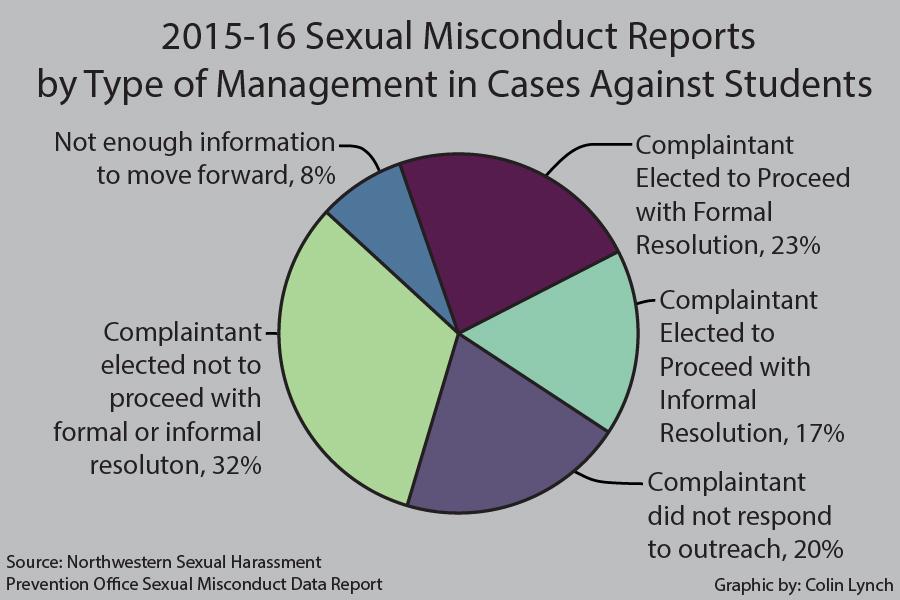University releases first annual sexual misconduct data report
January 6, 2017
The University made public its first data-rich report on sexual misconduct at Northwestern, revealing 179 complaints during the 2015-16 academic year.
The report is part of Northwestern’s commitment to increase transparency in response to a 2015 campus climate survey on sexual misconduct, Title IX coordinator Joan Slavin said in an email to The Daily. Undergraduate students were respondents in 55 of those reports, meaning they were alleged to have engaged in sexual misconduct. Faculty and staff members were respondents in 29 accounts, while 10 respondents were graduate students.
 In the 2015-16 academic year, 52 percent of total sexual misconduct reports were related to sexual harassment, while 26 percent were related to sexual assault. Allegations involving sexual assault as well as dating and domestic violence comprised 2 percent of the total reports.
In the 2015-16 academic year, 52 percent of total sexual misconduct reports were related to sexual harassment, while 26 percent were related to sexual assault. Allegations involving sexual assault as well as dating and domestic violence comprised 2 percent of the total reports.
“It is my hope that sharing the data will continue to raise awareness about how reports of sexual misconduct are handled at Northwestern and build trust in our complaint resolution process,” Slavin said in a news release.
The initial release date for the first annual report was set for summer 2016, but the report was published on the University’s website at the end of December. Slavin said the transition of sexual misconduct matters from the Office of Student Conduct to the Office of Sexual Harassment Prevention delayed the data’s release. The University announced in October that the Office of Sexual Harassment Prevention would handle all sexual misconduct cases.
“A lot of staff time this summer and fall was devoted to policy revision, development of a centralized complaint resolution process and transitioning student matters into the centralized office,” Slavin wrote in the email.
Slavin added that the office decided to cover data from the entire 2015-16 academic year, which started on Sept. 1, 2015, and did not end until Aug. 31, 2016.
Communication senior Amanda Odasz, outreach chair of Sexual Health and Assault Peer Educators, said the way sexual misconduct is handled by the administration has improved over the last several years. The release of this information is an indication of progress, Odasz said.
“It’s a really important step in increasing accountability and transparency from the school and helping building trust in students for the reporting process,” she said.
Regarding reports filed against students in the 2015-16 academic year, 32 percent of complaintants chose not to proceed with formal or informal resolution.
 “There are so many reasons why survivors would choose not to report or go through the formal complaint process, but I do think it is encouraging to see this data,” Odasz said. “At least some people have chosen to go through with the formal complaint resolution process and have been successful.”
“There are so many reasons why survivors would choose not to report or go through the formal complaint process, but I do think it is encouraging to see this data,” Odasz said. “At least some people have chosen to go through with the formal complaint resolution process and have been successful.”
Of the 17 student cases that proceeded through the formal resolution process during the 2015-16 academic year, seven resulted in expulsion or exclusion, while three resulted in the respondent being deemed “not responsible.” In the same set of student cases, six respondents received disciplinary probation, and one was suspended.
Dan Loizzo, president of Men Against Rape and Sexual Assault, said the report is a “wake-up call” for students to take action against sexual misconduct. Reporting sexual misconduct can often feel isolating, but the report shows survivors they are not alone in having gone through the resolution process, the Weinberg senior said.
“Sexual violence is occurring on Northwestern’s campus, and it is occurring to a large number of students,” Loizzo said. “It just sheds more light on things you can do to empower survivors.”
Email: [email protected]
Twitter: @lend_er_man

